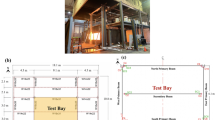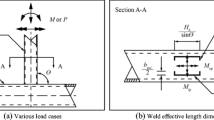Abstract
In this study, a finite element model of a top-seat angle connection at elevated temperature is developed to study the effect of axial restraints on the connection behavior. Models are first validated with existing fire test results of top-seat angle connection. Non-linear behavior of the materials was modeled with the definition of elastic-plastic multi-linear properties and frictional contact between surfaces is included to simulate actual conditions. Validation of the model behavior shows that the model is in good agreement with existing experimental results and therefore the model is used for further study on the effect of axial restraints towards connection behavior. Both isothermal and anisothermal conditions were analyzed considering the effect of axial restraints. Results from the model shows that an increase in axial restraints has increased connection capacity while the stiffness remains similar for low axial levels. On the other hand, the shrinkage of the beam, may lead to tensional axial loads, causing axial pulling on the connection, resulting in higher deformation and different deformation patterns of the component angle sections. Effect on the design guidelines for connection design with axial restraints provided by Eurocode 3:2005 (Part 1-8) is also discussed at the end.
Similar content being viewed by others
References
Azizinamini, A. (1982). Monotonic Response of semi-rigid steel beam to column connections, Master Thesis. University of South Carolina, Columbia.
Bo, Y. and Tan, K. H. (2012). “Numerical analyses of steel beamcolumn joints subjected to catenary action.” Journal of Constructional Steel Research, Vol. 70, pp. 1–11, DOI: 10.1016/j.jcsr.2011.10.007.
CEN. EN 1993-1-2, Eurocode 3 (2005). Design of steel structures–Part 1-2: General Rules-Structural Fire Design, London: British Standards Institution.
CEN.EN 1993-1–8, Eurocode 3 (2005). Design of steel structures, part 1.8: Design of joints, London: British Standards Institution.
Danesh, F., Pirmoz, A., and Saedi Daryan, A. (2007). “Effect of shear force on the initial stiffness of top and seat angle connections with double web angles.” Journal of Constructional Steel Research, Vol. 63, No. 9, pp. 1208–1218, DOI: 10.1016/j.jcsr.2006.11.011.
Hong, K., Yang, J. G.., and Lee, S. K. (2002). “Moment-rotation behavior of double angle connections subjected to shear load.” Engineering Structures, Vol. 24, No. 1, pp. 125–132, DOI: 10.1016/S0141-0296(01)00014-1.
Huang, Z. (2011). “A connection element for modelling end-plate connections in fire.” Journal of Constructional Steel Research, Vol. 67, No. 5, pp. 841–853, DOI: 10.1016/j.jcsr.2010.12.009.
Li, G. Q., Chen, L. Z., Li, J. T., and Lou, G. B. (2012b). “Modeling of end-plate bolted composite connection in fire considering axial force effects.” Journal of Constructional Steel Research, Vol. 76, pp. 133–143, DOI: 10.1016/j.jcsr.2012.03.021.
Li, J. T., Li, G. Q., Lou, G. B., and Chen, L. Z. (2012a). “Experimental investigation on flush end-plate bolted composite connection in fire.” Journal of Constructional Steel Research, Vol. 76, pp. 121–132, DOI: 10.1016/j.jcsr.2012.03.022.
Liu, T. C. H., Fahad, M. K., and Davies, J. M. (2002). “Experimental investigation of behaviour of axially restrained steel beams in fire.” Journal of Constructional Steel Research, Vol. 58, No. 9, pp. 1211–1230, DOI: 10.1016/S0143-974X(01)00062-1.
Mao, C. J., Chiou, Y. J., Hsiao, P. A., and Ho, M. C. (2009). “Fire response of steel semi-rigid beam-column moment connections.” Journal of Constructional Steel Research, Vol. 65, No. 6, pp. 1290–1303, DOI: 10.1016/j.jcsr.2008.12.009.
Pirmoz, A., Danesh, F., and Farajkhah, V. (2011. “The effect of axial beam force on moment–rotation curve of top and seat angels connections.” Struct. Design Tall Spec. Build., Vol. 20, No. 7, pp. 767–783, DOI: 10.1002/tal.551.
Qian, Z., Tan, K. H., and Burgess, I. (2008). “Behavior of steel beam-to-Column joints at elevated temperature: Experimental Investigation.” Journal of Structural Engineering, Vol. 134, No. 5, pp. 713–726, DOI: 10.1061/(ASCE)0733-9445(2008)134:5(713).
Ramli Sulong, N. H., Elghazouli, A. Y., Izzuddin, B. A., and Ajit, N. (2010). “Modelling of beam-to-column connections at elevated temperature using the component method.” Steel and Composite Structures, Vol. 10, No. 1, pp. 23–43, DOI: 10.12989/scs.2010. 10.1.023.
Reinosa, J. M., Loureiro, A., Gutiérrez, R., and Moreno, A. (2008). “Nonlinear elastic-plastic 3D Finite Element Modelling -Top and seat angle connections with double web angle.” Proceedings of the 5th European Conference on Steel and Composite Structures, Eurosteel 2008, Volume A, pp. 501–506, Graz.
Saedi Daryan, A. and Yahyai, M. (2009a). “Behavior of top-seat angle connections in fire.” Journal of Constructional Steel Research, Vol. 65, No. 3, pp. 531–541, DOI: 10.1016/j.jcsr.2008.07.021.
Saedi Daryan, A. and Yahyai, M. (2009b). “Modeling of bolted angle connections in fire.” Fire Safety Journal, Vol. 44, No. 7, pp. 976–968, DOI: 10.1016/j.firesaf.2009.06.005.
Wang, W. Y., Li, G. Q., and Dong, Y. L. (2007). “Experimental Study and Spring Component Modeling of Extended end-plate joints in fire.” Journal of Constructional Steel Research, Vol. 63, No. 8, pp. 1127–1137, DOI: 10.1016/j.jcsr.2006.10.006.
Wang, Y. C., Dai, X. H., and Bailey, C. G. (2011). “An experimental study of relative structural fire behavior and robustness of different types of steel joint in restrained steel frames.” Journal of Constructional Steel Research, Vol. 67, No. 7, pp. 1149–1163, DOI: 10.1016/j.jcsr.2011.02.008.
Yang, J. G., Murray, T. M, and Plaut, R. H. (2000). “Three-dimensional finite element analysis of double angle connections under tension and shear.” Journal of Constructional Steel Research, Vol. 54, No. 2, pp. 227–244, DOI: 10.1016/S0143-974X(99)00048-6.
Yin, Y. Z. and Wang, Y. C. (2005). “Analysis of catenary action in steel beams using a simplified hand calculation method, Part 1: theory and validation for uniform temperature distribution.” Journal of Constructional Steel, Vol. 61, No. 2, pp. 183–211, DOI: 10.1016/j.jcsr.2004.07.002.
Yu, H., Burgess, I. W., Davison, J. B., and Plank, R. J. (2008). “Experimental investigation of the behavior of flush end plate in fire.” Proceedings of the 6th Structures in Fire 2008, Singapore, DEStech Publications, Inc.
Author information
Authors and Affiliations
Corresponding author
Rights and permissions
About this article
Cite this article
Hean, L.S., Ramli Sulong, N.H. & Jameel, M. Effect of axial restraints on top-seat angle connections at elevated temperatures. KSCE J Civ Eng 20, 2375–2383 (2016). https://doi.org/10.1007/s12205-015-1129-y
Received:
Accepted:
Published:
Issue Date:
DOI: https://doi.org/10.1007/s12205-015-1129-y




